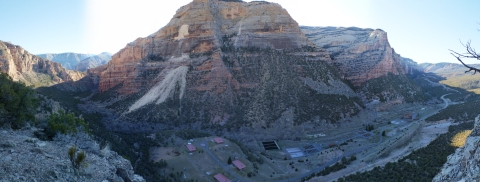About Us
Since 1871 the National Fish Hatchery System has been at work improving recreational fishing and restoring aquatic species that are in decline, at risk, and are important to the health of our aquatic systems. Across the country the network of national fish hatcheries work with states and Tribes to conserve, restore and enhance the fish and aquatic resources of America for future generations.
Jones Hole National Fish Hatchery provides management and production of trout for mitigation of Colorado River Storage Project waters of the Upper Colorado River System as well as to meet Tribal trust responsibilities on Native American land. Water for Jones Hole comes from an underground spring that can supply up to 15,000 gallons of water per minute. This volume of water is necessary to rear the large numbers of fish needed for stocking Colorado River Storage Project waters. The water temperature, 54 degrees Fahrenheit (13 degrees Celsius) year-round, is ideal for rearing trout. Current species reared at the hatchery include the Bonneville Cutthroat Trout, Kokanee Salmon, and Tiger Trout.
Our Mission
National fish hatcheries apply science-based approaches to conservation challenges. We work with our partners and engage the public to conserve, restore, and enhance fish and other aquatic resources for the continuing benefit of the American people. Conservation is at the heart of what we do, and we recognize that we do this work for the American people–both the present generation who benefit today and future generations who will inherit our legacy of conserving America’s aquatic resources.
As the natural aquatic habitat changes from natural (drought, flood, habitat destruction) or human influences (over-harvest, pollution, habitat loss due to development and dam construction), the natural production of fish declines. Stocking of fish is one of the many management strategies used by biologists to help replenish the populations for years to come.
Our History
Jones Hole National Fish Hatchery was founded in 1968, with the first trout produced in 1970, to provide management and production of trout for mitigation of Colorado River Storage Project waters of the Upper Colorado River System and to meet Tribal trust responsibilities on Native American land. Approximately 85% of all fish stocked from Jones Hole are released into Colorado River Storage Project waters, including Flaming Gorge, Steinaker Reservoir, and Redfleet Reservoir. The remaining fish are taken to Wind River Indian Reservation in Wyoming as well as some state-managed waters. Now, up to 1.2 million trout are raised annually.
The Naming of Jones Hole - after the indigenous Fremont people resided here, small waves of visitors came by way of what is now known as the Green River. One famously known explorer, Major John Wesley Powell camped on the banks of the Green in 1871 and decided to name this beautiful canyon in honor of his expedition's topographer, Stephen Vandiver Jones. But the name Jones Hole really took hold after an incident in 1883 involving a man named Charley Jones. Believing that he killed a man, Charley hid out in the canyon for a winter. When he later found out that the man had lived and he had not killed anyone, Charley exclaimed in relief, "You mean I can finally get out of this hole?" And thus, the name stuck.
Other Facilities in this Complex
Jones Hole NFH is part of a larger Utah Fisheries Complex with administrative officers in Vernal, Utah.


